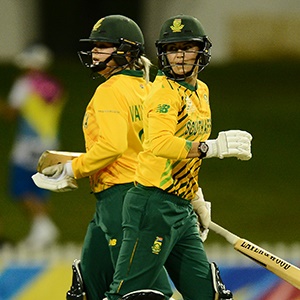|
Dane van Niekerk (left) and Marizanne Kapp (Getty) |
“Cricket is cricket and that is the part of the stigma we need to change. Men’s cricket and women’s cricket, we need to accept it for what it is.”
Dane van Niekerk has a gift for making hard-nosed, striking comments that don’t force recipients to fearfully go curl up into a corner.
Last month, the Proteas women’s skipper was queried over a suggestion by Graeme Smith, Cricket South Africa’s Director of Cricket, that the national team and its provincial feeders be given specialised input.
“We work just as hard, the skill is the same, we don’t hit the ball as far, but we do hit the ball. We bowl the ball, hit it and catch it. If we keep looking at it as men’s and women’s, we don’t go forward we need to look at it as cricket,” she said.
It was a pretty emphatic and justified retort, though she tempered it by also pointing out that Smith is a “passionate, stand-up guy”.
Whether it’s the case or not, when the phrase “specialist coaching” and women’s cricket are used in conjunction, there will be suggestions of stereotypification.
It comes with the territory.
Boundaries are shorter; the majority of batters are cultured, crisp strokemakers instead of sloggers and you won’t see many quicks bowling at true, menacing pace.
But then you witness Lizelle Lee or Chloe Tryon clearing the rope with consummate ease or Shabnim Ismail sending down a searing yorker … and wonder whether there really is much of a difference between the men’s and women’s game.
One person who agrees with Van Niekerk’s sentiments is Yashin Ebrahim, the national team’s head coach between 2010 and 2012.
“It’s really hard to find fundamental differences,” he told Sport24.
“Yes, women cricketers won’t hit a ball 100m regularly or bowl at 150km/h. But isn’t that just a question of genetic contrasts? Men and women play by the same rules, which mean the skillsets are the same. They also have the same overriding objective: to win a game of cricket.”
In fact, if you ask Ebrahim what would represent “specialised coaching”, he struggles to find an answer.
After a short pause, the former Dolphins coach reminds himself of the start of his tenure a decade ago, where he instituted a few drills.
Yet even those wouldn’t fit the definition.
“I remember when we would have throwdowns with the batters and help them practice a lap shot over fine leg or a reverse sweep. It was a skill we identified that needed harnessing,” said Ebrahim.
“But it still doesn’t mean it was coaching specifically designed for women. It was just general, value-adding skills.”
He does believe that the women’s game can benefit from a specialised programme at lower levels.
“One could implement initiatives that helps cultivate cricketing nous to schoolgirls, programmes that make them think more deeply about the game at an earlier age. I do believe thinking more about the game helps one cultivate big match temperament. It’s also the type of thing that could convince someone with a reasonable interest to really invest themselves in the game,” said Ebrahim.
“Unfortunately, the infrastructure is lacking, particular at lower provincial levels. There’s the cost factor to consider and I think there’s probably first need to be survey conducted to determine interest. Maybe there’s a possibility of starting smaller leagues to gradually build depth, but it will require will and hard work.”
Regardless of how questionable the pipeline is, the national team’s evolution is undeniable.
“I’m exceptionally proud of what the team has achieved. They are professional athletes who maintain unbelievably high standards and are clearly pursuing the goal of being one of the best sides in the world. One need not look further than what they’ve achieved recently at world tournaments.
“I’m confident they’ll keep it up,” said Ebrahim.


